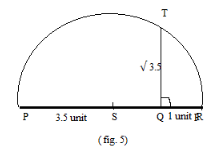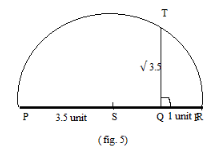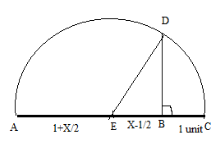
Find the value of \[\sqrt {3.5} \] geometrically.
Answer
563.4k+ views
Hint: Here we will follow some basic steps to draw the required number. Below are the steps that need to follow:
To mark any number \[\sqrt x \] on the number line, first of all, we will draw a line \[{\text{AB}}\] of \[x\] units.
After extending that line to \[1\] unit till point \[{\text{C}}\], we will find the midpoint of that particular line \[{\text{AC}}\] which is \[x + 1\] units, and marking it as point \[{\text{E}}\]
We will draw a semicircle after that taking \[{\text{E}}\] as a Centre point and \[{\text{AC}}\] as diameter.
After that, we will draw a perpendicular line from the point \[{\text{B}}\], which cuts the semicircle at the point \[{\text{D}}\].
So, \[{\text{BD}}\] is required \[\sqrt x \].
Complete step-by-step solution:
Step 1: For finding the value of
\[\sqrt {3.5} \] first of all we will draw a line of
\[3.5\] the unit as shown below:

Step 2: Now, by extending the line
\[{\text{PQ}}\] to \[1\] the unit, we get:

Step 3: Now we will find the midpoint of
\[{\text{PR = 4}}{\text{.5 unit}}\], which is a point
\[{\text{S}}\], by using the scale or by drawing the bisector of that line such that \[{\text{PS = SR = 2}}{\text{.25 unit}}\], as shown below:

Step 4: Now, by drawing a semicircle taking
\[{\text{S}}\] as a Centre point and \[{\text{PR}}\] as diameter, we get the below figure:

Step 5: Now by drawing a perpendicular line from the point
\[{\text{Q}}\] which cuts the semi-circle at the point \[{\text{T}}\], we get the below figure:

Step 6: Now, the line
\[{\text{QT}}\] is our required line of \[\sqrt {3.5} \] the unit.
Answer/Conclusion:
\[\because \] Our required figure is as below:

Note: Students can follow the below proof for calculating the value of any number
\[\sqrt x \] geometrically for their better understanding:
First of all, we will draw a line \[{\text{AB}}\] of \[x\] units. After extending that line to \[1\] unit till point \[{\text{C}}\], we will find the midpoint of that particular line \[{\text{AC}}\] which is \[x + 1\] units and marking it as a point \[{\text{E}}\]. We will draw a semicircle after that taking \[{\text{E}}\] as a Centre point and \[{\text{AC}}\] as diameter. After that we will draw a perpendicular line from the point \[{\text{B}}\], which cuts the semicircle at the point \[{\text{D}}\] as shown in the below diagram:

In the above diagram, we know that \[{\text{AC = }}x + 1\]. Because \[{\text{E}}\] is the midpoint of the line \[{\text{AC}}\] then, \[{\text{AE = }}\left( {\dfrac{{x + 1}}{2}} \right)\] and similarly we will find the value of \[{\text{EB}}\] as shown below:
\[ \Rightarrow {\text{EB = AB - AE}}\]
By substituting the value of \[{\text{AE = }}\left( {\dfrac{{x + 1}}{2}} \right)\] and \[{\text{AB = }}x\] in the above expression, we get:
\[ \Rightarrow {\text{EB = }}x{\text{ - }}\left( {\dfrac{{x + 1}}{2}} \right)\]
By simplifying the above expression, we get:
\[ \Rightarrow {\text{EB = }}\left( {\dfrac{{x - 1}}{2}} \right)\]
Now, by using Pythagoras theorem \[\Delta {\text{EDB}}\], we get:
\[ \Rightarrow {\left( {{\text{ED}}} \right)^2} = {\left( {{\text{EB}}} \right)^2} + {\left( {{\text{BD}}} \right)^2}\]
By substituting the values of \[{\text{EB = }}\left( {\dfrac{{x - 1}}{2}} \right)\] and \[{\text{ED = }}\left( {\dfrac{{x + 1}}{2}} \right)\], because \[{\text{ED}}\]is the radius of the circle, we get:
\[ \Rightarrow {\left( {\dfrac{{1 + x}}{2}} \right)^2} = {\left( {\dfrac{{x - 1}}{2}} \right)^2} + {\left( {{\text{BD}}} \right)^2}\]
By bringing \[{\left( {\dfrac{{x - 1}}{2}} \right)^2}\] into the LHS side of the expression, we get:
\[ \Rightarrow {\left( {\dfrac{{1 + x}}{2}} \right)^2} - {\left( {\dfrac{{x - 1}}{2}} \right)^2} = {\left( {{\text{BD}}} \right)^2}\]
By subtracting into the LHS side of the above expression we get:
\[ \Rightarrow \dfrac{{1 + {x^2} + 2x - {x^2} - 1 + 2x}}{4} = {\left( {{\text{BD}}} \right)^2}\]
By simplifying the numerator of the term \[\dfrac{{1 + {x^2} + 2x - {x^2} - 1 + 2x}}{4}\] , we get:
\[ \Rightarrow \dfrac{{4x}}{4} = {\left( {{\text{BD}}} \right)^2}\]
By eliminating \[4\] from the LHS side of the expression we get:
\[ \Rightarrow x = {\left( {{\text{BD}}} \right)^2}\]
By taking root on both sides of the above expression, we get:
\[ \Rightarrow \sqrt x = {\text{BD}}\]
Hence proved.
To mark any number \[\sqrt x \] on the number line, first of all, we will draw a line \[{\text{AB}}\] of \[x\] units.
After extending that line to \[1\] unit till point \[{\text{C}}\], we will find the midpoint of that particular line \[{\text{AC}}\] which is \[x + 1\] units, and marking it as point \[{\text{E}}\]
We will draw a semicircle after that taking \[{\text{E}}\] as a Centre point and \[{\text{AC}}\] as diameter.
After that, we will draw a perpendicular line from the point \[{\text{B}}\], which cuts the semicircle at the point \[{\text{D}}\].
So, \[{\text{BD}}\] is required \[\sqrt x \].
Complete step-by-step solution:
Step 1: For finding the value of
\[\sqrt {3.5} \] first of all we will draw a line of
\[3.5\] the unit as shown below:

Step 2: Now, by extending the line
\[{\text{PQ}}\] to \[1\] the unit, we get:

Step 3: Now we will find the midpoint of
\[{\text{PR = 4}}{\text{.5 unit}}\], which is a point
\[{\text{S}}\], by using the scale or by drawing the bisector of that line such that \[{\text{PS = SR = 2}}{\text{.25 unit}}\], as shown below:

Step 4: Now, by drawing a semicircle taking
\[{\text{S}}\] as a Centre point and \[{\text{PR}}\] as diameter, we get the below figure:

Step 5: Now by drawing a perpendicular line from the point
\[{\text{Q}}\] which cuts the semi-circle at the point \[{\text{T}}\], we get the below figure:

Step 6: Now, the line
\[{\text{QT}}\] is our required line of \[\sqrt {3.5} \] the unit.
Answer/Conclusion:
\[\because \] Our required figure is as below:

Note: Students can follow the below proof for calculating the value of any number
\[\sqrt x \] geometrically for their better understanding:
First of all, we will draw a line \[{\text{AB}}\] of \[x\] units. After extending that line to \[1\] unit till point \[{\text{C}}\], we will find the midpoint of that particular line \[{\text{AC}}\] which is \[x + 1\] units and marking it as a point \[{\text{E}}\]. We will draw a semicircle after that taking \[{\text{E}}\] as a Centre point and \[{\text{AC}}\] as diameter. After that we will draw a perpendicular line from the point \[{\text{B}}\], which cuts the semicircle at the point \[{\text{D}}\] as shown in the below diagram:

In the above diagram, we know that \[{\text{AC = }}x + 1\]. Because \[{\text{E}}\] is the midpoint of the line \[{\text{AC}}\] then, \[{\text{AE = }}\left( {\dfrac{{x + 1}}{2}} \right)\] and similarly we will find the value of \[{\text{EB}}\] as shown below:
\[ \Rightarrow {\text{EB = AB - AE}}\]
By substituting the value of \[{\text{AE = }}\left( {\dfrac{{x + 1}}{2}} \right)\] and \[{\text{AB = }}x\] in the above expression, we get:
\[ \Rightarrow {\text{EB = }}x{\text{ - }}\left( {\dfrac{{x + 1}}{2}} \right)\]
By simplifying the above expression, we get:
\[ \Rightarrow {\text{EB = }}\left( {\dfrac{{x - 1}}{2}} \right)\]
Now, by using Pythagoras theorem \[\Delta {\text{EDB}}\], we get:
\[ \Rightarrow {\left( {{\text{ED}}} \right)^2} = {\left( {{\text{EB}}} \right)^2} + {\left( {{\text{BD}}} \right)^2}\]
By substituting the values of \[{\text{EB = }}\left( {\dfrac{{x - 1}}{2}} \right)\] and \[{\text{ED = }}\left( {\dfrac{{x + 1}}{2}} \right)\], because \[{\text{ED}}\]is the radius of the circle, we get:
\[ \Rightarrow {\left( {\dfrac{{1 + x}}{2}} \right)^2} = {\left( {\dfrac{{x - 1}}{2}} \right)^2} + {\left( {{\text{BD}}} \right)^2}\]
By bringing \[{\left( {\dfrac{{x - 1}}{2}} \right)^2}\] into the LHS side of the expression, we get:
\[ \Rightarrow {\left( {\dfrac{{1 + x}}{2}} \right)^2} - {\left( {\dfrac{{x - 1}}{2}} \right)^2} = {\left( {{\text{BD}}} \right)^2}\]
By subtracting into the LHS side of the above expression we get:
\[ \Rightarrow \dfrac{{1 + {x^2} + 2x - {x^2} - 1 + 2x}}{4} = {\left( {{\text{BD}}} \right)^2}\]
By simplifying the numerator of the term \[\dfrac{{1 + {x^2} + 2x - {x^2} - 1 + 2x}}{4}\] , we get:
\[ \Rightarrow \dfrac{{4x}}{4} = {\left( {{\text{BD}}} \right)^2}\]
By eliminating \[4\] from the LHS side of the expression we get:
\[ \Rightarrow x = {\left( {{\text{BD}}} \right)^2}\]
By taking root on both sides of the above expression, we get:
\[ \Rightarrow \sqrt x = {\text{BD}}\]
Hence proved.
Recently Updated Pages
The number of solutions in x in 02pi for which sqrt class 12 maths CBSE

Write any two methods of preparation of phenol Give class 12 chemistry CBSE

Differentiate between action potential and resting class 12 biology CBSE

Two plane mirrors arranged at right angles to each class 12 physics CBSE

Which of the following molecules is are chiral A I class 12 chemistry CBSE

Name different types of neurons and give one function class 12 biology CBSE

Trending doubts
One Metric ton is equal to kg A 10000 B 1000 C 100 class 11 physics CBSE

What is 1s 2s 2p 3s 3p class 11 chemistry CBSE

Discuss the various forms of bacteria class 11 biology CBSE

State the laws of reflection of light

Explain zero factorial class 11 maths CBSE

An example of chemosynthetic bacteria is A E coli B class 11 biology CBSE




